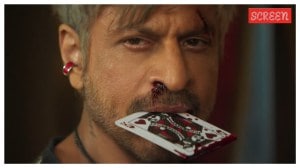The real Lala of Indian cricket
NEW DELHI, AUGUST 5: Lala Amarnath will ever remain one of the most enigmatic characters of Indian cricket. His life was so colourful that...

NEW DELHI, AUGUST 5: Lala Amarnath will ever remain one of the most enigmatic characters of Indian cricket. His life was so colourful that it is difficult to separate fact from folklore. No Indian cricketer has ever been as controversial, unpredictable, outspoken, or reckless and yet as exhilarating as Lala.
It was during one of his national coaching camps at the Doon School in Dehra Dun in 1970 that as a young student I first met Lala Amarnath. He invited me for breakfast and it was here that I had my first lessons on Indian cricket. He had so much to talk on the game. Later, I met him several times at the Karnail Singh Stadium during Railways’ Ranji Trophy matches in late 1970s and early 1980s when he was staying at Prasad Nagar in Karol Bagh.
Years later (August 1998 to be precise) during the inauguration of a cricket academy of his youngest son Rajinder at DPS School (Mathura Road), when I told Lalaji about our first meeting, he thought for a moment and then said: “Yes… yes. I remember.” He had an accurate memory, as accurate as his medium-pace inswingers on the 1946 England tour.
He also remembered the bat with which he scored a hundred in the second innings of his maiden Test. “It was a Gunn and Moore Non-Jar. I felt so happy to have been the team’s top-scorer (38) in the first innings,” he recalled.
Always dressed immaculately, Lalaji talked about his playing days and the way the game had changed over the years. As for the modern game, Lalaji would say: “Over-professionalism has the spoilt the game. But we never had such playing facilities in our times (looking at the pitches prepared at his son’s academy). The game is now getting all the attention in schools because of the money involved.”
His advice to young aspirants? “Play the game straight. Don’t get into sports politics.” Well, he should know, having seen it all during his playing days and having been at the receiving end.
There have been many stories and controversies regarding his name and his date of birth. He was named Amarnath Bhardwaj by his parents. Lala is a Punjabi address of respect and early in his international career, he got the name Lala Amarnath. And so he remained till he breathed his last.
“How does it matter,” he said once when asked to confirm his date of birth. “After my first tour of England, they had my birth year as 1906 (September 11). The quicker I reach my century (100 years), the sooner I can be felicitated,” he chuckled. Alas, his dream remained unfulfilled.
At school in Kapurthala where he was born, he played hockey and was a good long-distance runner. “I didn’t like getting hit on the knuckles. After we shifted to Aligarh I represented the university team in cricket. I was a wicketkeeper-batsman in my early days,” he said, talking about his childhood.
His finest innings? “The finest innings I played was on a sticky wicket at Chepauk on our way to Ceylon (Sri Lanka) in 1945. It was the final day of the match. We had lost four wickets for seven runs when I joined Vijay Merchant and I batted so well that I got my hundred before lunch.”
Another innings Lala remembered with pride was his unbeaten 104 in the Moin-ud-Dowla tournament at Hyderabad in 1934 when his team (The Retrievers) needed 178 to win. West Indian Learie Constantine headed the Freelooters’ attack. The match was played on coir matting. “Learie was a gentleman. He never bowled more than two bouncers an over,” he recalled.
Half of Lala’s 30-plus first-class hundreds were either made abroad or against sides visiting India. In Australia in 1947-48, he was in tremendous form in the state matches, with five centuries, but made only 140 runs in the Tests. “I think I bowled too much in the Tests. At times, I was overbowling,” he said, giving reason for his poor batting performance.
Remembering Don Bradman, Lala said: “He was the best puller of the ball.” The one time Lala dismissed Don Bradman marked the only occasion in his career Bradman was out hit-wicket.
Factfile
Lala Amarnath Nanik Bhardwaj
Born: 11 September 1911
Played for: India, Railways, UP, Maharajah of Patiala’s XI, Gujarat, Southern Punjab, Northern India.
Batting: Right Hand Bat; Bowling: Right Arm Medium Test Debut: India v England at Bombay, 1st Test, 1933/34
Last Test: India v Pakistan at Calcutta, 5th Test, 1952/53
LALA’S SONS
Surinder: 118 on first appearance for India in an unofficial Test against Sri Lanka; 124 on Test debut against New Zealand
Mohinder: 11 centuries in 69 Tests; Man of the Match in 1983 World Cup final
Rajinder: Played first-class cricket
LALA’S FIRSTS
* India’s first centurion in Test cricket
* First Indian to score century (118) on Test debut in 1933-34 against England
* Sent home from his first tour before the Tests began in 1936
* India’s captain on their first tour of Australia
* Member of India XI that first won a Test match
* India’s manager on their first tour of Pakistan (1955)
* Chairman of selectors when India first beat Australia.
- 01
- 02
- 03
- 04
- 05





























